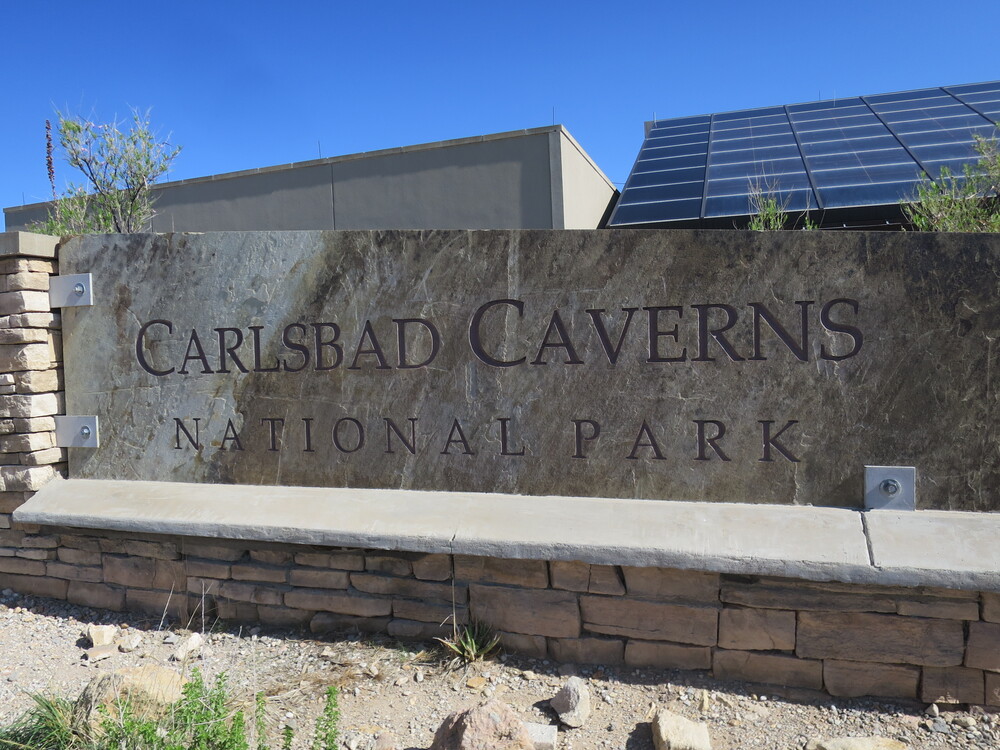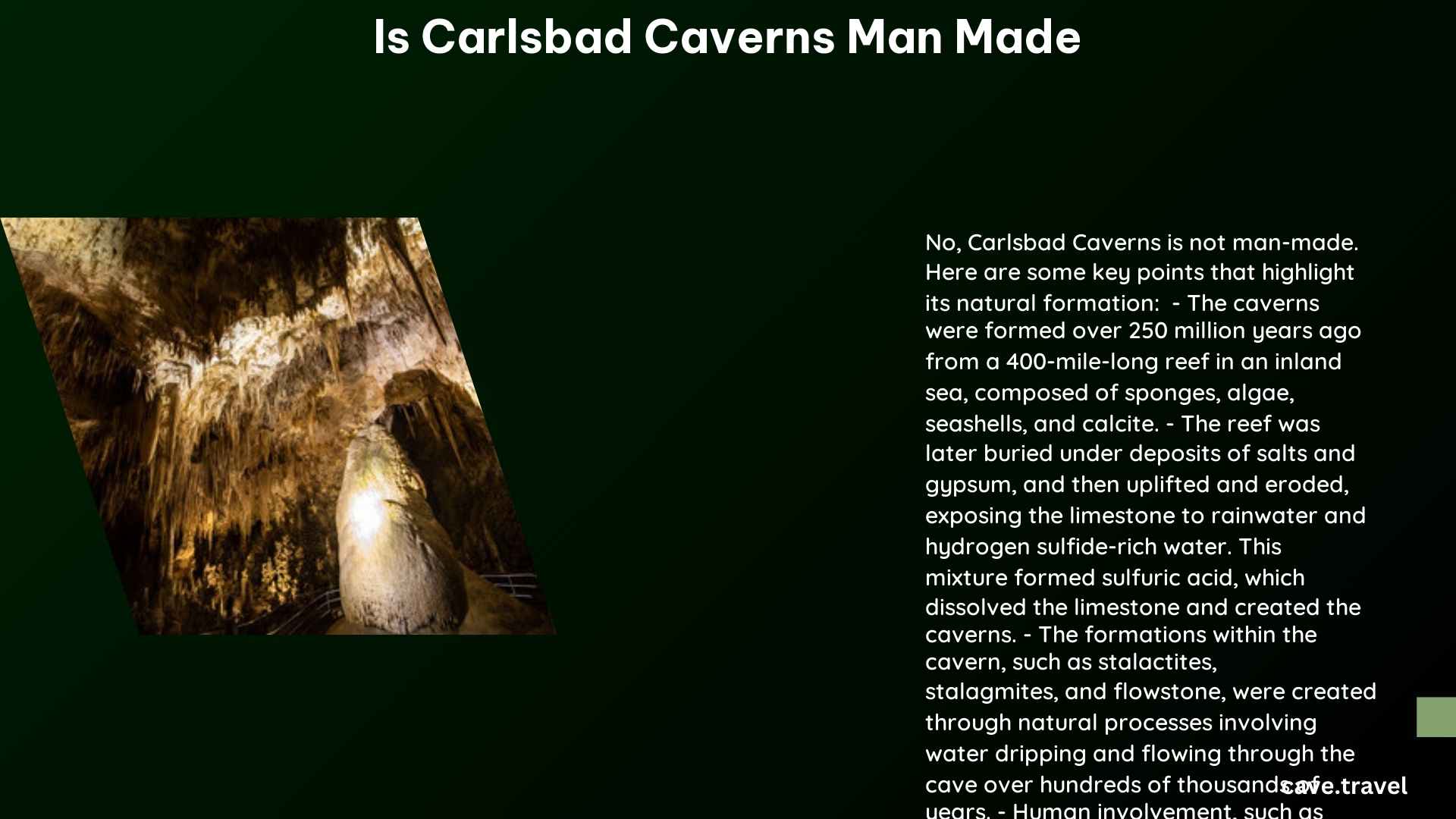Carlsbad Caverns is not man-made but a natural wonder formed over millions of years through geological processes. This vast underground system in New Mexico features enormous chambers, intricate rock formations, and unique ecosystems. While humans have added amenities for visitors, the caverns themselves are entirely natural, shaped by sulfuric acid dissolution of limestone. This article explores the origins, features, and significance of this remarkable natural formation.
What is the Origin of Carlsbad Caverns?

Carlsbad Caverns originated through a complex geological process spanning millions of years. The key factors in its formation include:
- Geological setting in the Guadalupe Mountains
- Sulfuric acid dissolution of limestone
- Upward movement of acidic waters
- Gradual enlargement of cave chambers over time
The caverns formed within the Capitan Limestone, a rock layer deposited during the Permian period about 265 million years ago. Unlike most caves formed by carbonic acid, Carlsbad Caverns resulted from sulfuric acid dissolution, a rarer and more aggressive process.
How Did Sulfuric Acid Shape the Caverns?

The unique formation process of Carlsbad Caverns involved:
- Hydrogen sulfide gas rising from deep petroleum deposits
- Oxidation of this gas to form sulfuric acid when mixed with groundwater
- Aggressive dissolution of limestone by the sulfuric acid
- Creation of large rooms and passages through this dissolution process
This sulfuric acid-driven formation is responsible for the caverns’ distinctive features, including massive chambers and intricate speleothems.
What Natural Features Characterize Carlsbad Caverns?
Carlsbad Caverns boasts an array of impressive natural features:
- The Big Room – a chamber spanning 14 acres with a 370-foot ceiling
- Stalactites and stalagmites of various sizes and shapes
- Delicate soda straw formations
- Massive columns where stalactites and stalagmites meet
- Intricate flowstone and drapery formations
- Unique “spongework” patterns on cave walls
These features developed naturally over thousands to millions of years through the slow deposition of minerals from water seeping through the limestone.
When Was Carlsbad Caverns Discovered?
The discovery and exploration of Carlsbad Caverns occurred in stages:
| Year | Event |
|---|---|
| Late 1800s | Local cowboys observe “smoke” (actually bats) rising from the hills |
| 1898 | Jim White, a teenage cowhand, begins exploring the caverns |
| 1923 | Carlsbad Cave National Monument established |
| 1930 | Carlsbad Caverns National Park created |
Jim White’s early explorations laid the groundwork for scientific study and eventual development of the caverns for public access.
What Man-Made Elements Exist in Carlsbad Caverns?
While the caverns themselves are natural, several man-made additions facilitate visitor access and safety:
- Paved walkways and handrails
- Electric lighting systems
- Elevators for easy access to the caverns
- Visitor center and educational displays
- Underground lunchroom and rest areas
These additions were carefully implemented to minimize impact on the natural environment while enhancing the visitor experience.
How Does Carlsbad Caverns Differ from Man-Made Caves?
Carlsbad Caverns exhibits several characteristics that distinguish it from artificial caves:
- Irregular and organic shapes of chambers and passages
- Presence of natural speleothems (stalactites, stalagmites, etc.)
- Evidence of long-term geological processes
- Unique microclimates and ecosystems
- Continuous formation of new mineral deposits
Man-made caves typically lack these natural features and the complex geological history evident in Carlsbad Caverns.
What Scientific Significance Does Carlsbad Caverns Hold?
Carlsbad Caverns offers valuable insights for various scientific fields:
- Geology: Study of rare sulfuric acid cave formation processes
- Hydrology: Understanding of ancient and current water systems
- Biology: Research on unique cave-dwelling organisms
- Paleontology: Examination of fossilized remains in cave deposits
- Climate science: Analysis of past climate conditions through cave formations
The caverns serve as a natural laboratory for scientists, providing data on Earth’s history and ongoing geological processes.
How Does Carlsbad Caverns Contribute to Biodiversity?
Despite its seemingly inhospitable environment, Carlsbad Caverns supports a diverse ecosystem:
- Bat populations, including Mexican free-tailed bats
- Cave-adapted invertebrates like cave crickets and isopods
- Unique microorganisms thriving in the cave environment
- Plant life near cave entrances adapted to low-light conditions
This biodiversity underscores the caverns’ importance as a natural habitat and its role in local and regional ecosystems.
In conclusion, Carlsbad Caverns stands as a testament to the power of natural geological processes. While human intervention has made this underground wonder accessible to visitors, the caverns themselves are entirely the product of millions of years of natural formation. Their unique features, scientific value, and ecological importance make Carlsbad Caverns a truly remarkable natural phenomenon, far beyond what any man-made structure could replicate.
References:
– http://www.jsjgeology.net/Carlsbad-Caverns.htm
– https://npshistory.com/publications/cave/nrr-2007-003.pdf
– https://www.geologyvirtualtrips.com/carlsbad-caverns-n-p
